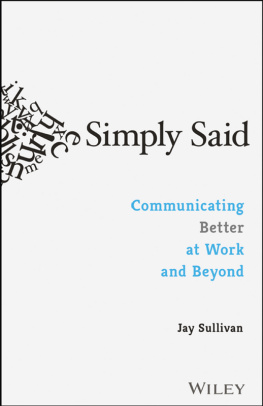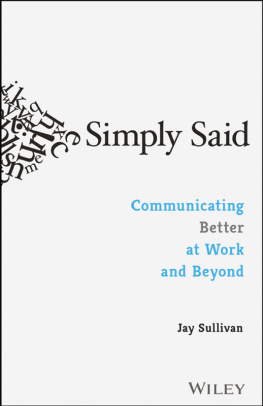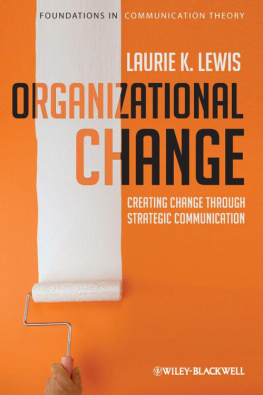
Cover designer: Anne Michele Abbott
This book is printed on acid-free paper.
Copyright 2014 by Kim Erwin. All rights reserved.
Published by John Wiley & Sons, Inc., Hoboken, New Jersey. Published simultaneously in Canada.
No part of this publication may be reproduced, stored in a retrieval system, or transmitted in any form or by any means, electronic, mechanical, photocopying, recording, scanning, or otherwise, except as permitted under Section 107 or 108 of the 1976 United States Copyright Act, without either the prior written permission of the Publisher, or authorization through payment of the appropriate per-copy fee to the Copyright Clearance Center, 222 Rosewood Drive, Danvers, MA 01923, (978) 750-8400, fax (978) 646-8600, or on the web at www.copyright.com. Requests to the Publisher for permission should be addressed to the Permissions Department, John Wiley & Sons, Inc., 111 River Street, Hoboken, NJ 07030, (201) 748-6011, fax (201) 748-6008, or online at www.wiley.com/go/permissions.
Limit of Liability/Disclaimer of Warranty: While the publisher and author have used their best efforts in preparing this book, they make no representations or warranties with the respect to the accuracy or completeness of the contents of this book and specifically disclaim any implied warranties of merchantability or fitness for a particular purpose. No warranty may be created or extended by sales representatives or written sales materials. The advice and strategies contained herein may not be suitable for your situation. You should consult with a professional where appropriate. Neither the publisher nor the author shall be liable for damages arising herefrom.
For general information about our other products and services, please contact our Customer Care Department within the United States at (800) 762-2974, outside the United States at (317) 572-3993 or fax (317) 572-4002.
Wiley publishes in a variety of print and electronic formats and by print-on-demand. Some material included with standard print versions of this book may not be included in e-books or in print-on-demand. If this book refers to media such as a CD or DVD that is not included in the version you purchased, you may download this material at http://booksupport.wiley.com. For more information about Wiley products, visit www.wiley.com.
Library of Congress Cataloging-in-Publication Data
Erwin, Kim, 1965
Communicating the new : how to make the complex, unfamiliar or still-fuzzy understandable to others / Kim Erwin.
pages cm
Includes index.
ISBN 978-1-118-39417-5 (pbk.); 978-1-118-41761-4 (ebk); 978-1-118-42198-7 (ebk)
1. Communication in marketing. 2. New products. 3. Business communication. 4. Communication in organizations. 5. Communication in management. I. Title.
HF5415.123.E79 2014
658.45--dc23
WHY THIS BOOK? WHY NOW?
What if you are working on a problem no one knows they have?
Editor of this book to the author of this book
If you are holding this book in your hands, you may already be persuaded that communication is critically important to success when pursuing new products, services, businesses, or systems. Powerful ideasthe lifeblood of any modern economywill be embraced, ignored, attacked, or rejected according to how well they are understood or represented.
You may also be holding this book because you believe something fundamental has changed, something that is making communication of The New more difficult, and standard communication techniques less effective. I have experienced this too, and I believe that a number of factors have come together to create a new context for communication:
We are working on problems of increasing complexity. This complexity is hard to manage, structure, and explainand yet it is essential to establishing the relevance of The New. We cannot ignore the complexity nor reduce it to an elevator pitch without trivializing our work.
The creation of The New involves more people. The creative typesthe scientists, designers, agency people, etc. have always had a hand in The New. Now, in an economy where speed of execution matters, we also need the developers the engineers, marketers, and IT specialists. Most critically, The New must be understood and embraced by the doers the sales staff, managers, and stakeholders of all kinds across the organization. This is no longer a problem of producing the best idea; its a challenge of engaging, leveraging, and aligning the human systems inside organizations.
We presume communication is occurring when in fact it is not. In most organizations, we believe that delivering informationin presentations, in reportsis communicating to others. At a time when co-creation is becoming the norm, our communication techniques appear stuck in a transmission model. Our conventional arsenal of delivery-based methods is no longer up to the task.
Communicating the New steps into this new reality with a simple approach and toolkit for all creators of The New. It collects and describes methods for employing communication, in an integral way, throughout the creation of new products, services, messages, or experiences. It introduces concepts and methods to help manage complexity, accelerate synthesis, bring clarity, and exchange important knowledge with the people who need to act on it. It is written for everyone who is involved in creating The Newfrom the account planner in advertising, to the manager of an internal innovation center, to the entrepreneur with a big idea. The aim of the book is functional: to provide a practical framework and tools that individuals and teams can use to help tame and frame the inherent complexity of creating The New. And maybe, just maybe, it will make the hard work of creating The New just a little bit easier.
In this book, you will meet individuals at the forefront of creating The New. Some are early pioneers; others are new arrivals. Some practice as consultants; others work directly within organizations. All share a new attitude toward communication. They use communication to clarify rather than persuade, deploying it not only at the end, but throughout the processto produce meaning and clarity, to advance ideas into concept, and to engage other people in advancing those ideas into the organizations and markets. This book draws from their experiences and organizes their contributions into a collection of methods for use by anyone who needs to communicate The New.
ACKNOWLEDGMENTS
Where to start? This has been more barn-raising than book writing.
I must first thank my husband, Tom Mulhern, my muse and my love. He is one of the most gifted communicators of The New that I knowand Im not alone in that assessment. We met and fell in love on the job, and the thinking in this book is very much a product of our journey together. His support has been unflagging and his contributions incalculable.
To our boys, Joey and Dakota, for their patience, thoughtful encouragement, and restrained eye-rolling during this process.
To Hugh Musick, for his inexhaustible support for this project and his steady encouragement of me personally. Hughs a talent in his own right. But hes also been instrumental to the promotion of ideas and others at the Institute of Design. Hughs conviction around what matters is invaluable to all of us at ID, and to this book in particular.
Id like to thank my editor, Margaret Cummins, for believing in a topic she wasnt sure anyone else would recognize and for putting money on a relatively unknown author. I believe that makes you a creator of The New, Margaret!
Next page












